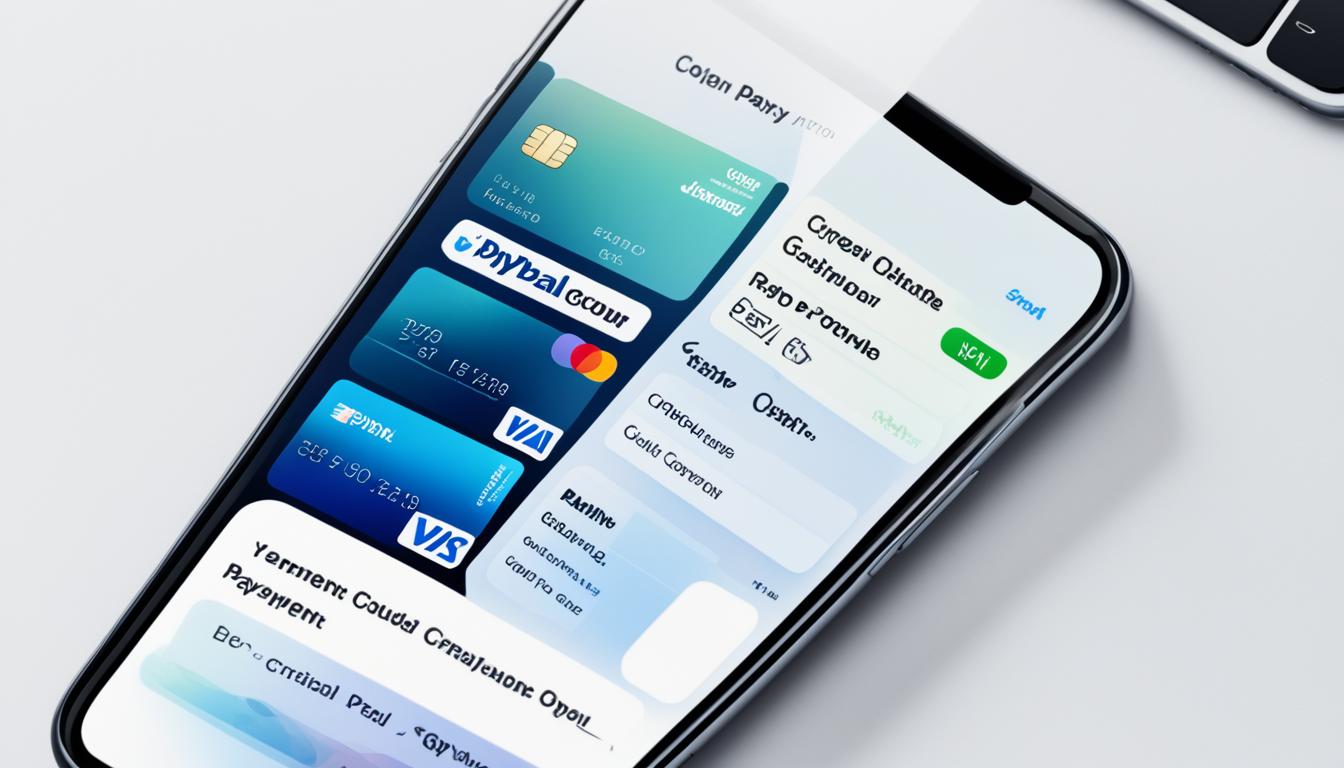Were you aware that 80% of consumers favor making online payments instead of traditional methods? Due to the growth of e-commerce and the growing demand for contactless transactions, it is crucial for businesses to accept payments online. Whether you are a small startup or a well-established company, having a smooth and secure payment system is crucial for meeting customer needs and increasing sales.
In this comprehensive guide, I will walk you through the step-by-step process of taking payments online. From choosing a payment processor to integrating a payment gateway and optimizing the payment process, you’ll learn everything you need to know to accept payments efficiently and securely.
Key Takeaways:
- Accepting payments online is crucial for businesses in today’s digital landscape.
- 80% of consumers prefer to make online payments over traditional methods.
- This guide will provide a step-by-step process on how to take payments online.
- Choosing the right payment processor and integrating a secure payment gateway are key steps in the process.
- Optimizing and monitoring the payment process is essential to ensure efficiency and security.
Types of Online Payment Methods
When it comes to accepting payments online, businesses have a wide range of options to choose from. Let’s explore the different types of online payment methods and their unique features:
Credit and Debit Cards
One of the most common and widely accepted payment methods online is through credit and debit cards. Customers can simply enter their card details during the checkout process, making it convenient and familiar for them.
Digital Wallets
Digital wallets, such as PayPal and Google Wallet, have gained popularity in recent years. These platforms allow users to securely store their payment information and make transactions with just a few clicks.
Bank Transfers
Bank transfers, also known as direct bank payments, enable customers to transfer funds from their bank accounts directly to the business. While this method may take longer to process, it eliminates the need for card or wallet details.
Cryptocurrencies
With the rise of cryptocurrencies like Bitcoin and Ethereum, businesses now have the option to accept digital currencies as payment. Crypto transactions offer increased security and privacy, although their adoption is still relatively niche.
Mobile Payments
The convenience of mobile devices has led to the growth of mobile payment options. Customers can make payments using their smartphones or tablets, either through dedicated apps or contactless payment technologies like Apple Pay and Google Pay.
In conclusion, businesses have a variety of online payment methods to choose from. Each method offers its own advantages and considerations, such as convenience, security, and target audience preferences. By understanding the different payment options available, businesses can cater to their customers’ needs and provide a seamless payment experience.
| Payment Method | Advantages | Considerations |
|---|---|---|
| Credit and Debit Cards | Convenient, widely accepted | Potential for chargebacks, transaction fees |
| Digital Wallets | Quick and easy transactions | User adoption, transaction fees |
| Bank Transfers | Secure, no need for card details | Longer processing times |
| Cryptocurrencies | Enhanced security, privacy | Niche adoption, volatility |
| Mobile Payments | Convenience, contactless options | Dependence on mobile devices, user adoption |
Components of Online Payment Processing
Online payment processing involves several components that work together to securely process and authorize transactions. These components include:
- Payment Gateway: A payment gateway acts as a bridge between the website or mobile app and the payment processor. It securely collects payment information from customers and sends it to the payment processor for authorization.
- Payment Processor: The payment processor is responsible for verifying payment information, such as credit card details, and authorizing transactions. It ensures that the funds are available and that the transaction is valid.
- Merchant Account: A merchant account is where transaction funds are held before they are transferred to the business’s bank account. It acts as an intermediary between the payment processor and the business.
- Acquiring Bank: The acquiring bank receives funds from the payment processor and transfers them to the business’s bank account. It ensures that the funds are settled in a timely manner.
- Security Measures: To protect against fraud and unauthorized transactions, online payment processing incorporates various security measures. These can include encryption, tokenization, two-factor authentication, and fraud detection systems.
By working together, these components ensure that online transactions are processed securely and efficiently, providing a seamless payment experience for both businesses and customers.
Real-world Example:
Imagine a customer making an online purchase. When the customer enters their payment information on the website, the payment gateway encrypts the data and securely transmits it to the payment processor. The payment processor then verifies the transaction details and checks for any red flags or suspicious activity. If the transaction is approved, the funds are held in the merchant account until they are transferred to the acquiring bank, which ultimately deposits the funds into the business’s bank account. Throughout this entire process, various security measures are in place to protect against fraud and ensure the transaction’s integrity.
Components of Online Payment Processing
| Component | Description |
|---|---|
| Payment Gateway | A bridge between the website or app and the payment processor, securely collecting payment information and transmitting it for authorization. |
| Payment Processor | Verifies payment information, authorizes transactions, and ensures the availability of funds. |
| Merchant Account | Holds transaction funds before transferring them to the business’s bank account. |
| Acquiring Bank | Receives funds from the payment processor and deposits them into the business’s bank account. |
| Security Measures | Various measures, such as encryption and fraud detection systems, implemented to protect against fraud and unauthorized transactions. |
Benefits of Accepting Online Payments
Accepting online payments offers several benefits for businesses. It provides convenience for customers, increases sales and revenue, reduces the risk of fraud and chargebacks, and streamlines accounting and reporting processes.
Convenience for Customers
One of the major advantages of accepting online payments is the convenience it offers to customers. With online payment options, customers can easily and securely make purchases from anywhere, anytime, using their preferred payment methods. This eliminates the need for customers to visit a physical store or send payments through traditional methods, making the shopping experience quick and hassle-free.
Increased Sales and Revenue
By accepting online payments, businesses can remove barriers to purchase and tap into a larger customer base. With online payment options, customers are more likely to complete the checkout process, leading to increased sales and revenue. Moreover, offering diverse payment methods, such as credit cards, digital wallets, and bank transfers, caters to customers’ preferences and encourages them to make larger and more frequent purchases.
Reduced Risk of Fraud and Chargebacks
Secure payment processing systems help reduce the risk of fraud and chargebacks for businesses. Online payments allow for robust security measures, such as encryption and tokenization, protecting sensitive customer information. Additionally, payment processors often offer fraud detection and prevention tools, minimizing the chances of fraudulent transactions. This not only safeguards businesses from financial losses but also enhances customer trust and loyalty.
Streamlined Accounting and Reporting Processes
Accepting online payments streamlines accounting and reporting processes for businesses. Automated payment systems generate accurate transaction records, eliminating the need for manual data entry. This saves time and reduces the risk of human error. Furthermore, payment processors often provide detailed reports and analytics, allowing businesses to gain insights into sales trends, customer behavior, and financial performance.

| Benefits of Accepting Online Payments | Description |
|---|---|
| Convenience for Customers | Customers can easily make purchases from anywhere, anytime, using their preferred payment methods. |
| Increased Sales and Revenue | Removing barriers to purchase and offering diverse payment methods encourage customers to make larger and more frequent purchases. |
| Reduced Risk of Fraud and Chargebacks | Secure payment processing systems and fraud detection tools minimize the chances of fraudulent transactions. |
| Streamlined Accounting and Reporting Processes | Automated transaction records and detailed reports save time, reduce errors, and provide insights into business performance. |
How to Accept Online Payments
Accepting online payments is a crucial aspect of running a successful business in today’s digital world. To ensure a smooth and secure payment process, businesses need to follow a series of steps. These steps include:
1. Choose a Payment Processor
First, select a payment processor that aligns with your business needs. Look for a provider that offers a range of payment methods, integrates well with your website or app, provides reliable customer support, and offers competitive pricing.
2. Set Up a Merchant Account
Next, set up a merchant account to receive funds from your online transactions. A merchant account acts as a holding account for your funds before they are deposited into your business bank account. You can typically set up a merchant account through your chosen payment processor or an acquiring bank.
3. Integrate a Payment Gateway
To accept online payments, you’ll need to integrate a payment gateway into your website or app. A payment gateway acts as a secure bridge between your business, the customer, and the payment processor. It encrypts sensitive payment information and verifies the transaction before transferring the funds to your merchant account. Your chosen payment processor will provide guidance on how to integrate their payment gateway into your platform.
4. Test and Launch
Before going live with your online payment system, it’s crucial to thoroughly test its functionality. Conduct test transactions using different payment methods to ensure everything is working smoothly. Once you’re confident in the system’s performance, you can launch your payment process and start accepting payments from customers.
5. Optimize and Monitor
After launching your online payment system, it’s important to continuously optimize and monitor its performance. Regularly review your transaction data, identify any areas for improvement, and optimize the payment process accordingly. Monitor for any security breaches, fraud attempts, or technical issues, and take prompt action to address them.
By following these steps, businesses can successfully set up and manage their online payment process. Remember to choose a payment processor, set up a merchant account, integrate a payment gateway, test and launch the system, and optimize and monitor it for continued success.

How to Choose an Online Payment Provider
When it comes to accepting payments online, choosing the right online payment provider is crucial for the success of your business. With the wide range of options available, it’s important to consider several factors before making a decision. Here are the key factors to consider when selecting an online payment provider: pricing, features, security, and customer support.
Pricing
One of the primary factors to consider when choosing an online payment provider is the pricing structure. You need to carefully review the fees associated with processing transactions, as well as any additional charges for services such as chargebacks or international payments. It’s important to find a provider that offers competitive rates and transparent pricing to ensure cost-effective payment processing.
Features
Every business has unique requirements when it comes to payment processing. Consider the features offered by different online payment providers and evaluate whether they meet your specific needs. Look for features such as customizable checkout options, recurring billing capabilities, and support for multiple payment methods. Choosing a provider with the right set of features will ensure a seamless payment experience for your customers.
Security
Security is paramount when it comes to online payments. Look for a payment provider that offers robust security measures to protect your customers’ sensitive information. Check if the provider is PCI-DSS compliant and offers encryption and tokenization technologies to safeguard payment data. Additionally, consider the fraud prevention tools and chargeback protection provided by the payment provider to minimize the risk of fraudulent transactions.
Customer Support
Having reliable customer support is essential when you’re dealing with payment processing. Choose a payment provider that offers responsive customer support to address any issues or concerns that may arise. Look for providers with various support channels, such as phone, email, and live chat, to ensure timely assistance.
By considering these factors, you can choose an online payment provider that aligns with your business needs and offers the best value for your money.
Now, let’s take a look at a comparison table of popular online payment providers:
| Payment Provider | Pricing | Features | Security | Customer Support |
|---|---|---|---|---|
| PayPal | Transaction fees + additional charges for certain services | Customizable checkout options, recurring billing, mobile payments | PCI-DSS compliant, encryption, fraud prevention tools | 24/7 support via phone, email, and chat |
| Stripe | Transaction fees + additional charges for certain services | Flexible APIs, subscription management, international payments | PCI-DSS compliant, tokenization, advanced fraud protection | 24/7 support via email and chat |
| Square | Flat rate per transaction with no additional charges | Point-of-sale integration, inventory management, invoicing | Encryption, PCI-DSS compliant, chargeback protection | 24/7 support via phone, email, and chat |

Please note that this table provides a brief overview and it’s important to conduct thorough research to find the best online payment provider for your business.
Accepting Credit and Debit Cards on a Website
Accepting credit and debit card payments on a website is essential for many businesses. In today’s digital age, customers expect the convenience of making purchases with their cards online. However, before implementing a payment processing solution, there are several factors to consider to ensure a smooth and secure transaction process.
Secure and Cost-Effective Payment Processing
When it comes to accepting credit and debit cards on a website, security and cost-effectiveness should be top concerns. It is crucial to choose a payment processing solution that provides robust security measures to protect both your business and your customers’ sensitive information. Look for a provider that offers encryption and tokenization features to safeguard card details during transmission and storage.
Additionally, consider the credit card payment processing fees and transaction fees charged by different payment processors. These fees can vary based on factors such as the volume of transactions and types of cards accepted. It is important to compare the fee structures of various providers to find a solution that aligns with your business’s budget and transaction volume.
Preventing Potential Fraud
Fraud is an unfortunate reality of online transactions, making it essential for businesses to implement fraud prevention measures. Look for a payment processing solution that offers advanced fraud detection and prevention tools, such as address verification systems (AVS), card verification codes (CVC), and 3D Secure authentication. These features provide an additional layer of protection against fraudulent transactions.
Furthermore, consider implementing fraud monitoring and reporting features that allow you to track suspicious activities and take immediate action to mitigate the risk of potential fraud.
Choosing a Payment Processor
Choosing the right payment processor is crucial for a seamless card payment experience on your website. Look for a provider that offers easy integration options compatible with your website’s platform. This will ensure a smooth and hassle-free setup process.
Consider the reputation and customer reviews of different payment processors to ensure reliability and excellent customer support in case any issues arise. Additionally, evaluate the availability of features such as recurring billing, mobile payment compatibility, and customizable payment forms to meet your business’s unique requirements.

Accepting credit and debit cards on your website opens up opportunities for increased sales and customer satisfaction. By choosing a secure and cost-effective payment processing solution that offers robust fraud prevention measures, you can provide a seamless and trustworthy payment experience for your customers.
Accepting ACH Payments on a Website
Accepting ACH payments on a website can provide businesses with a convenient and secure way to process electronic payments. ACH payment processing refers to accepting payments through the Automated Clearing House (ACH) Network, which enables the transfer of funds between bank accounts.
There are several benefits of accepting ACH transfers:
- Convenience: ACH payments offer convenience for both businesses and customers. Customers can easily make payments directly from their bank accounts, eliminating the need for credit or debit card information. Businesses can receive payments quickly and efficiently, reducing the hassle of manual payment processing.
- Easy Setup: Setting up ACH payment processing is relatively simple. Businesses need to partner with a payment processor or utilize a payment gateway that supports ACH transfers. Once the integration is completed, businesses can start accepting ACH payments with minimal effort.
- Enhanced Security: ACH transfers are considered secure due to the stringent protocols and safeguards implemented by the ACH Network. By accepting ACH payments, businesses can provide their customers with a secure payment option while reducing the risk of data breaches and unauthorized transactions.
It is important for businesses to be aware of certain considerations when using ACH transfers:
Transaction Limits: ACH transactions may be subject to certain limits imposed by banks or financial institutions. Businesses should familiarize themselves with these limits to ensure they can accommodate larger payment amounts if necessary.
Potential Penalties: Failure to comply with ACH rules and regulations can result in penalties or fines. It is essential for businesses to understand the guidelines and requirements set forth by the ACH Network to avoid any potential penalties.
By integrating ACH payment processing on their websites, businesses can offer customers a convenient and secure payment option while streamlining their payment collection process.

| Benefits of Accepting ACH Payments | Considerations for ACH Transfers |
|---|---|
| Convenience for customers | Transaction limits |
| Easy setup process | Potential penalties |
| Enhanced security |
Offering Recurring Billing or Subscriptions on a Website
Recurring billing and subscription payments are powerful tools that can help businesses automate their payment processes and enhance customer convenience. By implementing a reliable billing system and obtaining customer consent, businesses can streamline their operations and ensure timely payments.
With recurring billing, customers provide their payment information once, and the system automatically charges them on a set schedule. This eliminates the need for customers to manually make monthly or periodic payments, saving them time and effort. It also reduces the risk of missed payments, ensuring a steady and reliable revenue stream for businesses.
To offer recurring billing or subscriptions on your website, you need to choose a billing system that meets your specific requirements. Look for a solution that integrates seamlessly with your website and offers the necessary features such as automated payment scheduling, easy customer management, and secure payment processing.
When implementing recurring billing, it’s crucial to obtain proper customer consent. Clearly communicate the terms and conditions of the recurring billing or subscription service, including the payment schedule, cancellation policy, and any applicable fees. This ensures transparency and builds trust with your customers.
Here is an example of how you can structure your recurring billing or subscription system:
- Choose a reliable billing system that supports recurring payments.
- Integrate the billing system into your website, ensuring a seamless user experience.
- Obtain customer consent by clearly explaining the terms and conditions of the recurring billing or subscription service.
- Set up the billing system to automatically charge customers on the agreed-upon schedule.
- Regularly monitor and reconcile your recurring payment transactions.
By offering recurring billing or subscriptions on your website, you can automate payments, improve cash flow, and provide a convenient payment option for your customers.
Benefits of Offering Recurring Billing or Subscriptions:
“Recurring billing and subscriptions provide numerous benefits for both businesses and customers.”
| Benefits for Businesses | Benefits for Customers |
|---|---|
| Steady and predictable revenue stream | Convenience of automated payments |
| Reduced administrative overhead | Elimination of manual payment tasks |
| Improved cash flow and financial planning | Peace of mind knowing payments are handled automatically |
| Enhanced customer retention and loyalty | Ability to easily manage subscriptions |
Offering recurring billing or subscriptions can be a game-changer for businesses, simplifying payment processes and improving customer satisfaction. By choosing the right billing system and ensuring customer consent, you can automate payments and create a seamless payment experience.

Accepting Payments with Online Payment Devices and Tools
When it comes to accepting payments online, businesses have a plethora of options at their fingertips. Online payment devices and tools provide secure and convenient solutions for processing transactions. Let’s explore some of the popular choices:
PayPal
PayPal is one of the most recognized and widely used online payment tools. It allows businesses to accept payments from customers around the world using various methods, including credit cards, debit cards, and bank transfers. With PayPal, businesses can create a merchant account, integrate the payment gateway into their website or app, and securely process transactions.
Stripe
Stripe is another popular online payment tool that offers a comprehensive platform for accepting payments. It provides businesses with the flexibility to integrate Stripe’s API into their website or app, allowing for seamless payment processing. Stripe supports various payment methods and currencies, making it a versatile choice for businesses operating globally.
Square
Square is well-known for its payment devices and tools that enable businesses of all sizes to accept payments anywhere. From the sleek Square Reader to the robust Square Terminal, businesses can choose the device that best suits their needs. Square offers an easy-to-use platform and transparent pricing, making it an attractive option for small businesses and independent sellers.
Contactless Payment
Contactless payment options have gained popularity in recent years. With the rise of smartphones and smartwatches, customers can now make payments by simply waving their devices in front of contactless payment terminals. This technology, known as Near Field Communication (NFC), provides a quick and secure way for customers to complete transactions. Businesses can leverage contactless payment devices and tools to offer a seamless checkout experience.

In Summary
Online payment devices and tools like PayPal, Stripe, Square, and contactless payment options provide businesses with secure and convenient methods of accepting payments. Whether you choose to integrate one of these tools or explore other options, leveraging online payment devices and tools is essential in today’s digital landscape. By offering customers diverse payment options, you can maximize sales and provide a seamless checkout experience.
Can You Accept Payments on a Website?
As more businesses recognize the importance of expanding their online presence, accepting payments on a website has become a crucial aspect of success. Whether you have an ecommerce store, offer online services, or run a nonprofit organization, integrating a payment system on your website can provide convenience for your customers and help you reach a wider audience.
Accepting credit card payments on your website is especially important, as credit cards are one of the most commonly used methods for online transactions. By incorporating a secure and reliable payment processing solution, you can offer your customers a seamless checkout experience and increase your chances of closing sales.
In addition to accepting credit card payments, various businesses also need to integrate other payment methods such as digital wallets, mobile payments, and bank transfers. By offering a wide range of payment options, you can cater to the preferences of different customer segments and enhance their overall shopping experience.
Key businesses that greatly benefit from accepting payments on their websites include:
- Ecommerce retailers: Whether you sell physical products or digital goods, accepting online payments allows you to attract a global customer base and streamline your sales process.
- Service providers: Accepting payments on your website is essential if you offer services such as web design, consulting, or online classes. It enables you to secure bookings, request deposits, and receive payments hassle-free.
- Nonprofit organizations: Accepting donations through your website provides a convenient way for supporters to contribute to your cause. This can help you increase funding and make a greater impact.
By accepting payments on your website, you can foster trust and credibility with your customers while expanding your revenue potential. It also allows you to automate the payment process, saving you time and resources that would otherwise be spent on manual invoicing and reconciliation.
“Accepting payments on a website provides convenience for customers and expands market reach.”
To illustrate the benefits of accepting payments on a website, let’s take a look at the following table:
| Benefits of Accepting Payments on a Website | Benefits Explained |
|---|---|
| Convenience for customers | Customers can easily make purchases or donations from the comfort of their own homes, eliminating the need for physical visits or paperwork. |
| Expanded market reach | Accepting online payments allows you to reach customers beyond your local area, opening up new markets and opportunities for growth. |
| Increased revenue | By removing barriers to purchase, such as limited payment options or geographical restrictions, you can attract more customers and boost your sales. |
| Streamlined payment process | Automating the payment process on your website reduces manual work, allowing you to focus on other aspects of your business. |
As you can see, accepting payments on your website offers a range of benefits that can enhance your business operations and improve customer satisfaction. If you haven’t already implemented a payment system on your website, now is the time to explore your options and choose a solution that aligns with your business goals.

How Much Does It Cost to Accept Payments on a Website?
Accepting payments on a website is an essential component of running an online business. However, it’s important to understand the cost implications associated with this process. The expenses can vary depending on various factors, including payment processing fees, monthly fees, setup fees, chargeback fees, and fees for specific card types. Here’s a breakdown of these potential costs:
Payment Processing Fees
Payment processing fees are charges imposed by the payment processor for each transaction processed on your website. These fees are typically calculated as a percentage of the transaction amount or as a fixed fee per transaction. It’s crucial to compare different payment processors to find the one offering competitive rates that align with your business needs.
Monthly Fees
Some payment processors may charge a monthly fee for their services, often based on the volume of transactions or specific features included in the package. These fees cover the costs of using the payment processor’s infrastructure and additional services provided.
Setup Fees
Setup fees, also known as application or onboarding fees, are charges incurred when setting up an account with a payment processor. These fees typically cover the administrative costs associated with creating and integrating your payment system.
Chargeback Fees
A chargeback occurs when a customer disputes a transaction and requests a refund from their credit card issuer. Chargeback fees are charges imposed by the payment processor for managing and processing these disputes. It’s important to review the chargeback policies of different payment processors and choose a provider with reasonable fees and effective dispute resolution processes.
Fees for Specific Card Types
Some payment processors may charge additional fees for specific types of cards, such as corporate or international cards. These fees are often higher due to the increased risk associated with processing such transactions. It’s essential to understand the fee structure for different card types and consider the impact on your overall cost when choosing a payment processor.
When selecting a payment processor for your website, it’s vital to carefully review the pricing details and terms of service of different providers. Consider your business’s transaction volume, the types of payments you expect to receive, and the level of customer support and security measures offered. By choosing the most cost-effective option that aligns with your business needs, you can optimize your payment process and reduce unnecessary expenses.

Benefits and Risks of Accepting Payments on a Website
Accepting payments on a website can have numerous advantages and opportunities for businesses, but it is essential to be aware of the risks that come with it. Let’s explore the benefits and risks of implementing online payment systems.
Benefits of Accepting Payments on a Website
Accepting payments on a website offers several benefits:
- Convenience: Customers can easily make payments from anywhere at any time, providing a seamless and user-friendly experience.
- Expanded Reach: Online payments enable businesses to reach a wider audience across different geographical locations, enhancing market penetration.
- Efficiency: Automated payment processing streamlines transactions, reducing manual efforts and optimizing operational efficiency.
Now let’s dive into the risks associated with accepting payments on a website.
Risks of Accepting Payments on a Website
While accepting payments on a website offers numerous benefits, it is crucial to be aware of the potential risks:
- Fraud and Security Issues: Cybersecurity threats and potential data breaches pose a risk to sensitive customer information and can lead to financial losses.
- Chargebacks: Chargebacks occur when customers dispute transactions, leading to potential financial losses, administrative burdens, and reputational damage.
- Technical Issues: Technical glitches or system failures can disrupt payment processing, leading to transaction errors and dissatisfied customers.
- Regulatory Compliance: Businesses must comply with various payment industry regulations and data protection laws to ensure legal and ethical payment practices.
It is important for businesses to carefully consider these risks and implement robust security measures, fraud prevention tools, and strict compliance protocols.
“Accepting payments on a website offers convenience, expanded reach, and efficiency, but businesses must also address risks related to fraud, chargebacks, technical issues, and regulatory compliance.”
By understanding both the benefits and risks of accepting payments on a website, businesses can make informed decisions and implement effective strategies to maximize the advantages while mitigating potential drawbacks.
Continue reading to learn how to effectively accept payments from customers on a website.
How to Accept Payments from Customers on a Website
Accepting payments from customers on a website is an essential aspect of running a successful online business. To ensure a seamless payment process, there are several steps that need to be followed:
- Identify your business needs: Before choosing a payment processor, it’s important to identify your specific business needs. Consider factors such as the nature of your products or services, the volume of transactions, and your target audience.
- Choose a payment processor: Selecting the right payment processor for your website is crucial. Look for a processor that offers secure payment options, competitive pricing, and features that align with your business requirements.
- Create an account: Once you’ve chosen a payment processor, create an account with them. Provide the necessary information and documentation to get your account set up smoothly.
- Integrate the payment processor: Integrate the payment processor into your website or online platform. This usually involves adding code snippets or utilizing plugins provided by the payment processor.
- Configure payment settings: Customize your payment settings to align with your business needs. Set up pricing, currency options, and any other specific settings required for your business.
- Test the system: Before launching the payment system, thoroughly test it to ensure everything is functioning correctly. Perform test transactions and check if the payments are being processed accurately.
- Launch the payment system: Once you’re satisfied with the testing phase, it’s time to officially launch the payment system on your website. Make sure to provide clear instructions to customers on how to complete payments.
- Manage transactions: Regularly monitor and manage transactions made through your website. Keep track of successful payments, refunds, chargebacks, and any other financial activities related to customer payments.
- Comply with requirements: Ensure that your payment system complies with legal and regulatory requirements. This may include adhering to security standards, protecting customer data, and maintaining proper accounting records.
By following these steps, you can accept payments from customers on your website with ease, providing a seamless and secure payment experience for your customers.

Conclusion
Accepting payments online is essential for businesses in today’s digital era. By following the steps outlined in this guide, businesses can effectively take payments, provide a seamless customer experience, and streamline their operations.
First, it is important to choose the right payment processor that aligns with your business needs. Research different providers and compare pricing, features, security measures, and customer support to make an informed decision.
Next, set up a merchant account to receive funds and integrate a payment gateway into your website or app. This will ensure smooth and secure payment processing, allowing your customers to make transactions effortlessly.
Finally, optimize and monitor your payment process to enhance security and efficiency. Regularly review and update your payment system to stay up-to-date with the latest industry standards and regulations.
By implementing these strategies and utilizing secure payment options, businesses can maximize their potential for growth and success in the digital realm. Embrace the power of online payments and provide your customers with a seamless and convenient payment experience.
FAQ
What are the types of online payment methods?
What are the components of online payment processing?
What are the benefits of accepting online payments?
How do I accept online payments?
How do I choose an online payment provider?
How do I accept credit and debit card payments on a website?
How do I accept ACH payments on a website?
How do I offer recurring billing or subscriptions on a website?
What online payment devices and tools are available for businesses?
Can I accept payments on my website?
How much does it cost to accept payments on a website?
What are the benefits and risks of accepting payments on a website?
How do I accept payments from customers on a website?
Is Enabling Shopify Payments the Same as Accepting Payments for Businesses?
Yes, enabling Shopify Payments is the same as accepting payments for businesses. When setting up Shopify Payments, merchants can accept credit card payments from customers without the hassle of integrating third-party payment gateways. It provides a seamless and secure payment experience for both merchants and customers.









